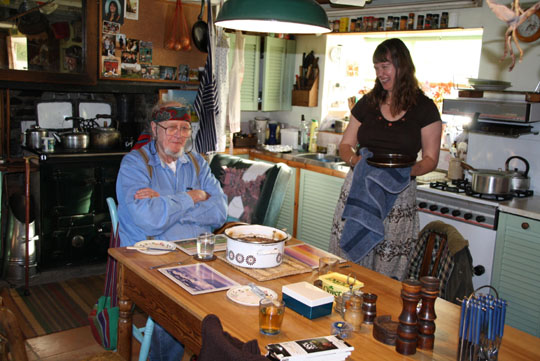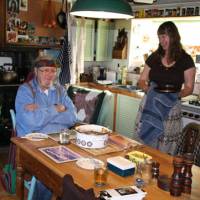It was 1954 and the summer holidays were over. The family had moved a few miles south from Tewkesbury to Cheltenham in the beautiful county of Gloucestershire in the west of England, and I had been transferred from the one town's boys grammar school to the other's.
On my very first day there, a small gang of boys gathered around, asking questions, curious about the new boy in the third year. Then all heads turned as a magnificent, classic open-topped Bugatti roared into the playground. The boys all gave a mighty cheer and raced to surround the car.
"Who's that?" I yelled out to one boy as he passed me.
"Dad," he said, "Dad Driver!"
That was very confusing at the time, as the car obviously had a driver, and the big, bearded man at the wheel didn't look old enough to be the dad of anybody in this school.
It turned out that the name of the driver in question was Driver, and the boys all called him "Dad" — perhaps because he was so imposing, and was the most charismatic and popular teacher in the school. For me, he was to become the best teacher I ever had; one who changed my whole life.
Ever since I'd started secondary school, biology had been my favorite subject, and Peter Driver was a superb biology teacher with a sense of humor he enjoyed sharing with us boys. He was immensely strong and, quite unlike any other schoolteacher, he had the confidence to join me at the local judo club.
We boys were dismayed when Peter left the school to take his young family, a dog and a squirrel over to Canada in order to do research for a doctorate at McGill University in Montreal. His research on the behavior of eider ducks was sponsored by a Carnegie Arctic Research Scholarship and by the Arctic Institute of North America. Peter had worked with Konrad Lorenz and Niko Tinbergen, both Nobel laureates, and although he enjoyed teaching, he yearned to do more fieldwork and research himself.
When Peter left, I was so depressed that for a while I lost all interest in school studies and devoted myself more and more to judo, weight-training and just roaming around the countryside with a backpack and rudimentary camping gear. Then, out of the blue, a letter arrived from Peter inviting me to join him as his assistant on his first expedition to the Canadian Arctic.
In truth, Peter was really strict in the field, and at times quite cranky, so I was more of a slave than a research assistant. It was good for me, though, because every teenager needs discipline — me especially. He later wrote that he chose me because of my physical strength, tenacity . . . and wacky sense of humor.
In April 1958, three months before my 18th birthday, I sailed across the Atlantic on an Empress liner out of Liverpool. In Montreal I helped to prepare for the expedition, doing all kinds of odd jobs, selecting equipment, making special crates and so on. Sometimes, too, I'd end up baby-sitting Peter's young son Alastair, which I didn't mind at all because I was very fond of my own little brother, and Alastair was a delightful lad to be with. I never dreamt at the time that one day he would be a board member of the C. W. Nicol Afan Woodland Trust up here in the Kurohime hills of Nagano Prefecture.
That first expedition was to Ungava Bay in northern Quebec, in an area just above the tree line. It was a superb experience, but tough. Other than a monotonous daily diet of bannock (a thick Scottish bread made without yeast and fried in a pan) and tea, we lived mostly off the land, which meant fishing and hunting when possible, also picking berries, Boletus mushrooms and other edible wild plants (some of which were taught to us by passing Inuit hunters).
There were plenty of ducks, but no matter how tempting they might look to a hungry man, Peter wouldn't allow a single one to be taken because he was studying live ones and didn't want his data shot.
The tents proved to be too small, so we built a hut with a dry-stone wall, a fireplace and chimney, and a roof of tree trunks, turf and moss. As I said, we were above the tree line, so all the logs and poles had to be carried or dragged over the tundra or along the rocky shore. The rocks were mostly rounded, wave-washed lumps of miserable heaviness, and it took a lot of artistry on Peter's part to not only make them fit together but to stand up and stay in place.
As the snow melted and it got warmer, this heavy, sweaty manual labor had to be carried out while we were being tormented by swarms of mosquitoes in numbers unimaginable to anybody who has not lived on the tundra. Even so, I thought the hut was rather fine, but in Peter's own words, as he later wrote in his book "In Search of the Eider": "Not that I can claim any pretensions of architectural grandeur for our construction. But it stayed up eventually. And at least it blended with the environment. On the other hand it was, I must admit, somewhat primitive. It served — well, tolerated — us for a couple of months, and was still standing when we left. But I like to think that in years to come, some fervent tundra archaeologist will discover it and go into printed raptures about the architecturally primitive nature of the natives who once inhabited that part of Quebec-Labrador."
Peter also invited me on his second expedition in 1959, this time to the remote and mysterious Belcher Islands in Hudson Bay — so I couldn't have been too much of a pain in the neck on the first one. (That book, "In Search of the Eider," is his highly readable account of those expeditions and his unique research; while in 1988 he coauthored with D.A. Humphries, another former student, a superb text on animal behavior, titled "Protean Behavior — The Biology of Unpredictability."
Fifty years have passed. Peter is still one of my dearest friends. For the last 30 or so years he has made the Orkney Islands his home. This summer I went to ask him for advice on the directions we should take with our woodland research. His words were simple, but I knew exactly what he meant.
"Always look for the connections," he said.
In 2010, I'll be 70. How time flies! If I have learned anything, it is to realize that truly, all life is connected. And if you look closely, that can be said of all our lives too.






















With your current subscription plan you can comment on stories. However, before writing your first comment, please create a display name in the Profile section of your subscriber account page.